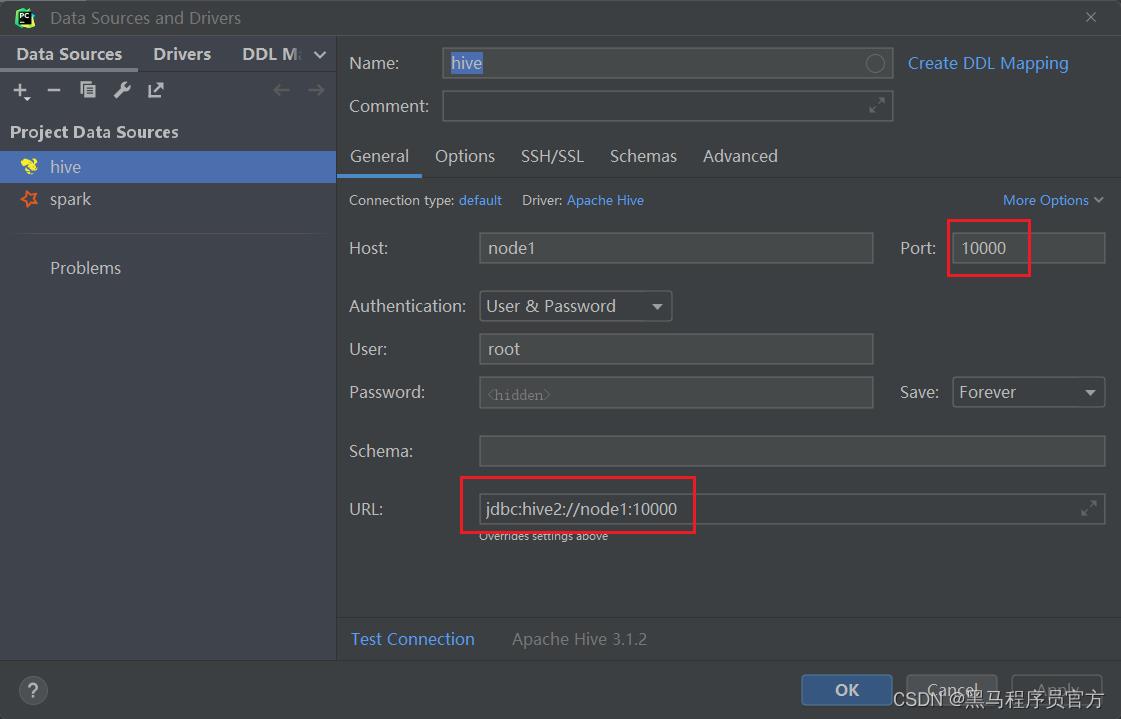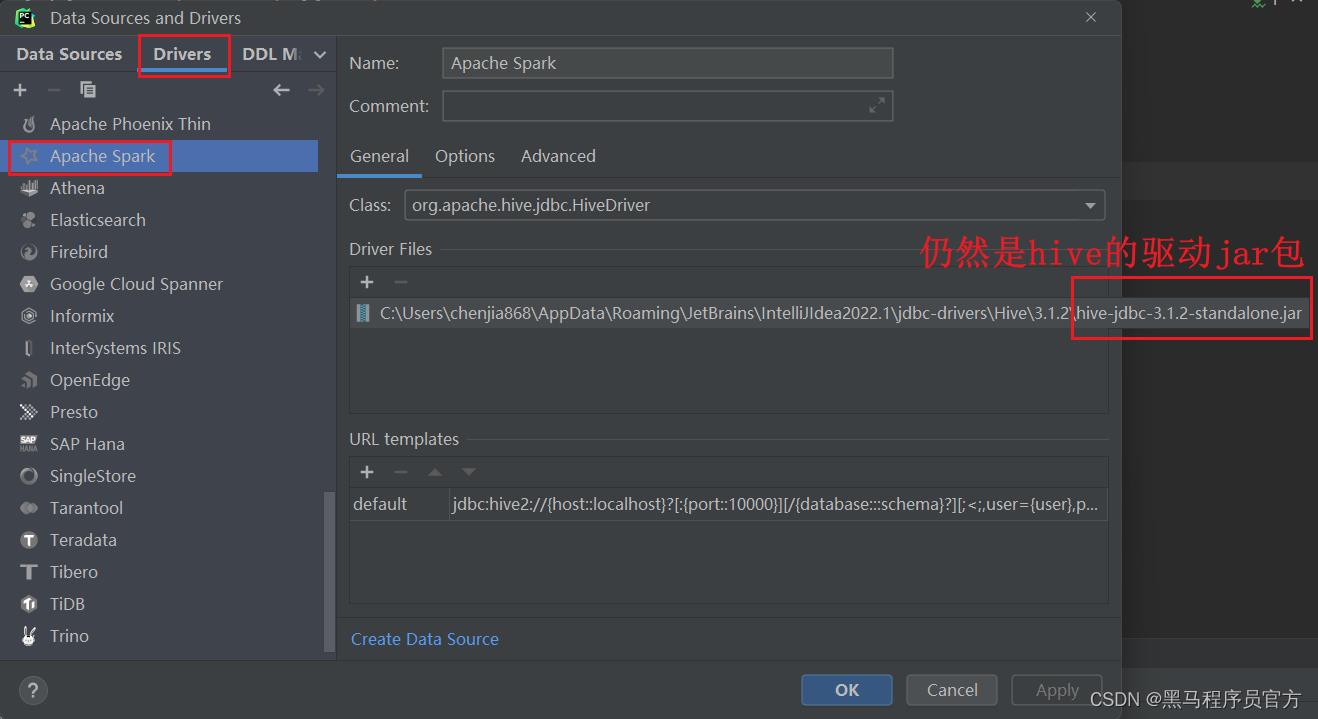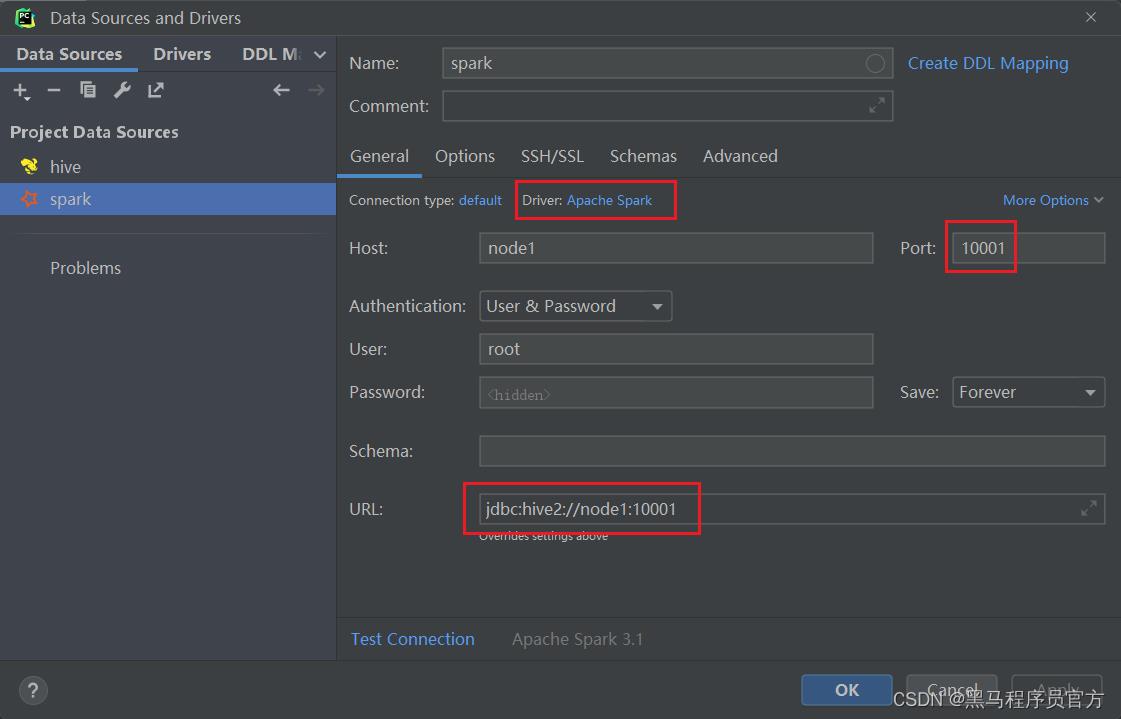以金融证券游戏电商等案例详解SQL强化
Posted 黑马程序员官方
tags:
篇首语:本文由小常识网(cha138.com)小编为大家整理,主要介绍了以金融证券游戏电商等案例详解SQL强化相关的知识,希望对你有一定的参考价值。
SQL强化
SQL执行顺序
--举例:
select
a.sex,
b.city,
count(1) as cnt,
sum(salary) as sum1
from table1 a
join table2 b on a.id=b.id
where a.name=b.name
group by a.sex,b.city
having cnt>=2
order by a.sex,b.city
limit 10
--或者是
select distinct
a.sex,
b.city,
a.age
from table1 a
join table2 b on a.id=b.id
where a.name=b.name
order by a.sex,b.city
limit 10
上面的SQL语句的执行顺序是: from (去加载table1 和 table2这2个表 ) -> join -> on -> where -> group by->select 后面的聚合函数count,sum -> having -> distinct -> order by -> limit
--on 和where的先后顺序讨论
--下面用left join 各得到结果,结果不一样。
--下面可知,先执行on,再执行where
select *
from table1 a
left join table2 b
on a.id=b.id
where a.name=b.name;
--下面的条数可能会比上面多。
select *
from table1 a
left join table2 b
on a.id=b.id
and a.name=b.name;
--下面用inner join 各得到结果,结果是一样的
select *
from table1 a
join table2 b
on a.id=b.id
where a.name=b.name;
select *
from table1 a
join table2 b
on a.id=b.id
and a.name=b.name;
hivesql与sparkSQL的区别:
子查询hive必须起别名,SparkSQL可以不用起别名
group by xx,yy,hive不用能用别名,spark可以用别名
hive不支持临时视图和缓存表,SparkSQL都支持
--用SparkSQL的临时视图 use interview_db; create or replace temporary view t_view1 as select *, if(month=1,amount,0) as a1, if(month=2,amount,0) as a2, if(month=3,amount,0) as a3, if(month=4,amount,0) as a4 from table2;select year,
sum(a1) as m1,
sum(a2) as m2,
sum(a3) as m3,
sum(a4) as m4
from t_view1
group by year;–使用SparkSQL的缓存表
cache table cached1 as
select *,
if(month=1,amount,0) as a1,
if(month=2,amount,0) as a2,
if(month=3,amount,0) as a3,
if(month=4,amount,0) as a4
from table2;select * from cached1;
select year,
sum(a1) as m1,
sum(a2) as m2,
sum(a3) as m3,
sum(a4) as m4
from cached1
group by year;* 爆炸函数,hive不支持explode与普通字段联合使用,需要用侧视图分开,SparkSQL支持联合使用 * ```sql use interview_db; select qq,game1 from tableB lateral view explode(split(game,'_')) view1 as game1 ; --spark还支持这样,但是hive不支持: select qq,explode(split(game,'_')) game1 from tableB ;
sparkSQL支持300多种函数,hiveSQL支持200多种函数。sparkSQL函数比hiveSQL要多。
- 比如SparkSQL有sequence函数,hive就没有
-
先配置环境
-
在pycharm或datagrip或idea中配置hive数据源。也可以配置一个sparkSQL数据源,来加快速度。
-
如果配置hive数据源:
-
需要提前启动hdfs和yarn,hive的metastore,hive的hiveserver2
-
#启动hdfs和yarn start-all.sh # hive的metastore nohup /export/server/hive/bin/hive --service metastore 2>&1 > /tmp/hive-metastore.log & #hive的hiveserver2 #hiveserver2开启后,等过2分钟后才能生效。 nohup /export/server/hive/bin/hive --service hiveserver2 2>&1 > /tmp/hive-hiveserver2.log &
-

- 如果遇到下面的问题

-
解决办法
-
hive/conf/hive-env.sh中加入 export HADOOP_CLIENT_OPTS=" -Xmx512m" export HADOOP_HEAPSIZE=1024 改完重启hiveserver2
-
-
如果配置SparkSQL数据源
-
需要提前启动hdfs,hive的metastore,Spark的Thriftserver服务。
-
#启动hdfs和yarn start-all.sh # hive的metastore nohup /export/server/hive/bin/hive --service metastore 2>&1 > /tmp/hive-metastore.log & #Spark的Thriftserver服务 /export/server/spark/sbin/start-thriftserver.sh \\ --hiveconf hive.server2.thrift.port=10001 \\ --hiveconf hive.server2.thrift.bind.host=node1 \\ --master local[*] -
下面是spark3集成hive3需要的jar包,如果是spark2集成hive2,则jar包不一样。
-

-

show databases ;
create database if not exists test_sql;
use test_sql;
-- 一些语句会走 MapReduce,所以慢。 可以开启本地化执行的优化。
set hive.exec.mode.local.auto=true;-- (默认为false)
--第1题:访问量统计
CREATE TABLE test_sql.test1 (
userId string,
visitDate string,
visitCount INT )
ROW format delimited FIELDS TERMINATED BY "\\t";
INSERT overwrite TABLE test_sql.test1
VALUES
( 'u01', '2017/1/21', 5 ),
( 'u02', '2017/1/23', 6 ),
( 'u03', '2017/1/22', 8 ),
( 'u04', '2017/1/20', 3 ),
( 'u01', '2017/1/23', 6 ),
( 'u01', '2017/2/21', 8 ),
( 'u02', '2017/1/23', 6 ),
( 'u01', '2017/2/22', 4 );
select *,
sum(sum1) over(partition by userid order by month1 /*rows between unbounded preceding and current row*/ ) as `累积`
from
(select userid,
date_format(replace(visitdate,'/','-'),'yyyy-MM') as month1,
sum(visitcount) sum1
from test_sql.test1
group by userid,
date_format(replace(visitdate,'/','-'),'yyyy-MM')) as t;
-- 第2题:电商场景TopK统计
CREATE TABLE test_sql.test2 (
user_id string,
shop string )
ROW format delimited FIELDS TERMINATED BY '\\t';
INSERT INTO TABLE test_sql.test2 VALUES
( 'u1', 'a' ),
( 'u2', 'b' ),
( 'u1', 'b' ),
( 'u1', 'a' ),
( 'u3', 'c' ),
( 'u4', 'b' ),
( 'u1', 'a' ),
( 'u2', 'c' ),
( 'u5', 'b' ),
( 'u4', 'b' ),
( 'u6', 'c' ),
( 'u2', 'c' ),
( 'u1', 'b' ),
( 'u2', 'a' ),
( 'u2', 'a' ),
( 'u3', 'a' ),
( 'u5', 'a' ),
( 'u5', 'a' ),
( 'u5', 'a' );
--(1)每个店铺的UV(访客数)
-- UV和PV
-- PV是访问当前网站所有的次数
-- UV是访问当前网站的客户数(需要去重)
--(2)每个店铺访问次数top3的访客信息。输出店铺名称、访客id、访问次数
select shop,
count(distinct user_id) as uv
from test_sql.test2 group by shop ;
--上面的拆解来看,等价于
--distinct后可以接多个字段,表示联合去重
select shop,
count(user_id) as uv
from
(select distinct shop,
user_id
from test_sql.test2 ) as t
group by shop ;
--也等价于
select shop,
count(user_id) as uv
from
(select shop,
user_id
from test_sql.test2 group by shop, user_id) as t
group by shop ;
select * from
(select *,
row_number() over (partition by shop order by cnt desc) as rn
from
(select shop,user_id,count(1) as cnt from test_sql.test2 group by shop,user_id ) as t) t2
where t2.rn<=3;
-- 第3题:订单量统计
CREATE TABLE test_sql.test3 (
dt string,
order_id string,
user_id string,
amount DECIMAL ( 10, 2 ) )
ROW format delimited FIELDS TERMINATED BY '\\t';
INSERT overwrite TABLE test_sql.test3 VALUES
('2017-01-01','10029028','1000003251',33.57),
('2017-01-01','10029029','1000003251',33.57),
('2017-01-01','100290288','1000003252',33.57),
('2017-02-02','10029088','1000003251',33.57),
('2017-02-02','100290281','1000003251',33.57),
('2017-02-02','100290282','1000003253',33.57),
('2017-11-02','10290282','100003253',234),
('2018-11-02','10290284','100003243',234);
-- (1)给出 2017年每个月的订单数、用户数、总成交金额。
-- (2)给出2017年11月的新客数(指在11月才有第一笔订单)
select date_format(dt,'yyyy-MM') as month1,
count(distinct order_id) as cnt1,
count(distinct user_id) as cnt2,
sum(amount) as amt
from test_sql.test3
where year(dt)=2017
group by date_format(dt,'yyyy-MM');
select count(user_id) cnt from
(select user_id,
min(date_format(dt,'yyyy-MM')) min_month
from test3 group by user_id) as t where min_month='2017-11';
--统计每个月的新客户数
select min_month,
count(user_id) cnt
from (select user_id,
min(date_format(dt, 'yyyy-MM')) min_month
from test3
group by user_id) as t
group by min_month;
-- 第4题:大数据排序统计
CREATE TABLE test_sql.test4user
(user_id string,name string,age int);
CREATE TABLE test_sql.test4log
(user_id string,url string);
INSERT INTO TABLE test_sql.test4user VALUES('001','u1',10),
('002','u2',15),
('003','u3',15),
('004','u4',20),
('005','u5',25),
('006','u6',35),
('007','u7',40),
('008','u8',45),
('009','u9',50),
('0010','u10',65);
INSERT INTO TABLE test_sql.test4log VALUES('001','url1'),
('002','url1'),
('003','url2'),
('004','url3'),
('005','url3'),
('006','url1'),
('007','url5'),
('008','url7'),
('009','url5'),
('0010','url1');
select * from test_sql.test4user ;
select * from test_sql.test4log ;
--有一个5000万的用户文件(user_id,name,age),
-- 一个2亿记录的用户看电影的记录文件(user_id,url),根据年龄段观看电影的次数进行排序?
--取整函数有 round,floor,ceil
select *,
round(x,0) as r,--四舍五入
floor(x) as f,--向下取整
ceil(x) as c--向上取整
from
(select 15/10 as x union all
select 18/10 as x union all
select 24/10 as x union all
select 27/10 as x ) as t;
select type,
sum(cnt) as sum1
from
(select *,
concat(floor(age/10)*10,'-',floor(age/10)*10+10) as type
from test_sql.test4user as a
-- join前最好提前减小数据量
join (select user_id,count(url) as cnt from test_sql.test4log group by user_id) as b
on a.user_id=b.user_id) as t
group by type
order by sum(cnt) desc;
-- 第5题:活跃用户统计
CREATE TABLE test5(
dt string,
user_id string,
age int)
ROW format delimited fields terminated BY ',';
INSERT overwrite TABLE test_sql.test5 VALUES ('2019-02-11','test_1',23),
('2019-02-11','test_2',19),
('2019-02-11','test_3',39),
('2019-02-11','test_1',23),
('2019-02-11','test_3',39),
('2019-02-11','test_1',23),
('2019-02-12','test_2',19),
('2019-02-13','test_1',23),
('2019-02-15','test_2',19),
('2019-02-16','test_2',19);
select * from test_sql.test5 order by dt,user_id;
--有日志如下,请写出代码求得所有用户和活跃用户的总数及平均年龄。(活跃用户指连续两天都有访问记录的用户)
-- type 总数 平均年龄
-- '所有用户' 3 27
-- '活跃用户' 1 19
with t1 as (select distinct dt, user_id,age from test_sql.test5),
t2 as (select *,row_number() over (partition by user_id order by dt) as rn from t1 ),
t3 as (select *,date_sub(dt,rn) as dt2 from t2),
t4 as (select dt2,user_id,age,count(1) cnt from t3 group by dt2,user_id,age),
t5 as (select * from t4 where cnt>=2),
t6 as (select distinct user_id,age from t5)
select '所有用户' as type, count(user_id) cnt,avg(age) as avg_age
from (select distinct user_id,age from test_sql.test5) t union all
select '活跃用户' as type, count(user_id) cnt,avg(age) as avg_age from t6;
-- 用思路2来分析连续2天登录
with t1 as (select distinct dt, user_id from test_sql.test5),
t2 as (select *,
date_add(dt,1) as dt2,
lead(dt,1)over(partition by user_id order by dt) as dt3
from t1)
select count(distinct user_id) from t2 where dt2=dt3;
-- 第6题:电商购买金额统计实战
CREATE TABLE test_sql.test6 (
userid string,
money decimal(10,2),
paymenttime string,
orderid string);
INSERT INTO TABLE test_sql.test6 VALUES(以上是关于以金融证券游戏电商等案例详解SQL强化的主要内容,如果未能解决你的问题,请参考以下文章